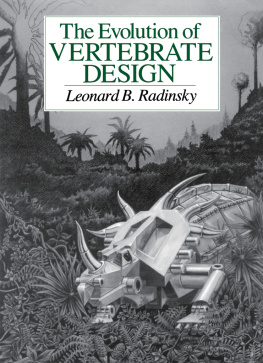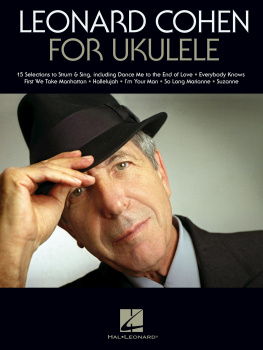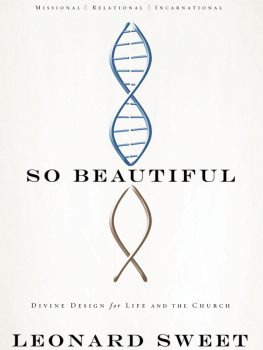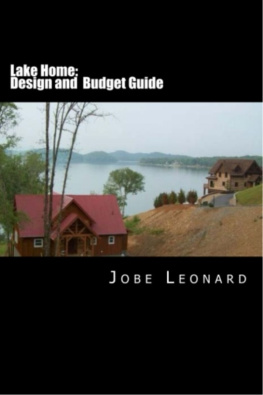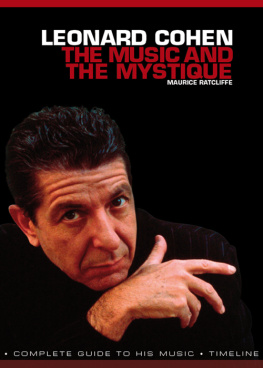Leonard B. Radinsky - The Evolution of Vertebrate Design
Here you can read online Leonard B. Radinsky - The Evolution of Vertebrate Design full text of the book (entire story) in english for free. Download pdf and epub, get meaning, cover and reviews about this ebook. year: 1987, publisher: The University of Chicago Press, genre: Romance novel. Description of the work, (preface) as well as reviews are available. Best literature library LitArk.com created for fans of good reading and offers a wide selection of genres:
Romance novel
Science fiction
Adventure
Detective
Science
History
Home and family
Prose
Art
Politics
Computer
Non-fiction
Religion
Business
Children
Humor
Choose a favorite category and find really read worthwhile books. Enjoy immersion in the world of imagination, feel the emotions of the characters or learn something new for yourself, make an fascinating discovery.
- Book:The Evolution of Vertebrate Design
- Author:
- Publisher:The University of Chicago Press
- Genre:
- Year:1987
- Rating:3 / 5
- Favourites:Add to favourites
- Your mark:
- 60
- 1
- 2
- 3
- 4
- 5
The Evolution of Vertebrate Design: summary, description and annotation
We offer to read an annotation, description, summary or preface (depends on what the author of the book "The Evolution of Vertebrate Design" wrote himself). If you haven't found the necessary information about the book — write in the comments, we will try to find it.
The Evolution of Vertebrate Design — read online for free the complete book (whole text) full work
Below is the text of the book, divided by pages. System saving the place of the last page read, allows you to conveniently read the book "The Evolution of Vertebrate Design" online for free, without having to search again every time where you left off. Put a bookmark, and you can go to the page where you finished reading at any time.
Font size:
Interval:
Bookmark:
THE EVOLUTION OF VERTEBRATE DESIGN
Leonard B. Radinsky

The University of Chicago Press
Chicago and London
The University of Chicago Press, Chicago 60637
The University of Chicago Press, Ltd., London
1987 by The University of Chicago
All rights reserved. Published 1987
Printed in the United States of America
16 15 14 13 12 11 10 09 08 07 7 8 9 10 11
ISBN-13: 978-0-226-22063-5 (ebook)
ISBN-13: 978-0-226-70236-0 (paper)
ISBN-10: 0-226-70236-7 (paper)
Library of Congress Cataloging-in-Publication Data
Radinsky, Leonard B.
The evolution of vertebrate design.
Bibliography: p.
Includes index.
1. VertebratesEvolution. 2. Vertebrates, Fossil. I. Title.
QL607.5.R33 1987 596'.038 87-5959
 The paper used in this publication meets the minimum requirements of the American National Standard for Information SciencesPermanence of Paper for Printed Library Materials, ANSI Z39.48-1992.
The paper used in this publication meets the minimum requirements of the American National Standard for Information SciencesPermanence of Paper for Printed Library Materials, ANSI Z39.48-1992.
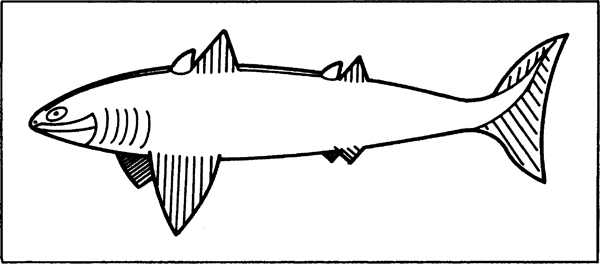

To Adam, Josh, and Leah
Publishers Note
Leonard B. Radinsky was born in 1937, the son of Russian-Polish immigrants, in Staten Island, New York. He developed a keen love of fossils as a young boy and at the age of thirteen produced a short book illustrated by himself, entitled Prehistoric Animals. He did undergraduate work at Cornell University and received the masters and doctorate degrees from Yale University. After a postdoctoral fellowship at the American Museum of Natural History, he taught at Boston University and Brooklyn College and then in 1967 joined the University of Chicago faculty.
Leonard Radinsky died of cancer in August 1985. At the time of his death, he was professor and former chairperson in the Department of Anatomy at the University of Chicago. During his distinguished career in biology, he published numerous scientific and popular articles, the best known of which are those on the neuroanatomy of extinct mammals and the functional morphology of carnivores.
Among friends, Lens love of teaching is especially well remembered. The Evolution of Vertebrate Design was written as an outgrowth of his course on vertebrate morphology, paleontology, and evolution for undergraduates not majoring in biology in the College of the University of Chicago. He wanted his students to appreciate the evolution of vertebrates through an understanding of how their body form, or design, changed through evolutionary time. Finding no text that combined information on functional morphology and paleontology, he decided to write this book himself. He was in the process of revising the manuscript when he died. The work of completing the book was done by Sharon B. Emerson. The Press is very pleased to publish The Evolution of Vertebrate Design, and we share its authors hope that it will bring some of the excitement of the evolution of vertebrate life on earth to the students who read it.
Acknowledgements
There are many people who helped Len with his book. Harry Greene, Lynne Houck, Jim Hopson, Keith Thomson, John Bolt, George Lauder, and Mike LaBarbera all read early versions of various chapters. Their comments and criticisms were greatly appreciated. Jack Sepkoski, Philip Gingerich, Jacques Gauthier, Jim Hopson, Eric Lombard, and George Lauder contributed comments and data for figures. Discussions with Martin Feder, George Lauder, Jim Hopson, and Eric Lombard were particularly helpful to me. Dennis Green did a wonderful job of translating Lens ideas and sketches into finished figures. Ruth Bachman compiled the glossary and helped read proof.
Susan Abrams took a special interest in Lens book from the beginning. Her strong emotional and professional support are largely responsible for the books completion. Finally, Len would certainly have wanted to acknowledge the love and encouragement of his friends. And so, a special thanks to Lynne Houck, Steve Arnold, Harry Greene, Kristine Tollestrup, Jeanne and Stuart Altmann, Susan and Brock Cole, Steve Gould, Ann Sakai, Steve Weller, Brigid Hogan, Martha McClintock, Pam Parker, and Wim Weijs.
Sharon Emerson
THE EVOLUTION OF VERTEBRATE DESIGN

CHAPTER 1
Introduction: Fossils and Phylogeny
The history of vertebrate life is a fascinating story, one that chronicles the rise and fall of numerous groups of organisms, including strange and bizarre types like nothing alive in the world today. It is a story of major evolutionary transformations over millions of years, of long periods of little or no change, and of disastrous worldwide extinctions and great evolutionary radiations. And, of course, the story includes our own evolutionary history, which can be traced from our early ancestors among ancient jawless fish. This book will look at the important changes in basic body organization that have occurred over the past 500 million years and at the periodic evolutionary radiations that produced a stunning diversity of life forms at various points in time. Emphasis is placed on explaining the functional significance of evolutionary changes in anatomical structure. We will look at the evidence and methods of analysis used to obtain those explanations, so that you can see how we have come to our current understanding of ancient life forms.
Sources of Information
We have two main sources for the evolutionary history of the vertebrates: the fossil record and the diversity of living vertebrates. The fossil record is very incomplete, for it preserves evidence of only a very small percentage of all the species that ever existed, and it usually provides information only on their hard parts or skeletons. However, it is our only source of information about extinct species. The fossil record is set in the framework of geological time and therefore can provide direct evidence of actual evolutionary transformations at fairly specific periods through time. Furthermore, with careful analysis, skeletal remains can provide much insight into the ways of life of extinct animals.
Fossils are the traces or remains of extinct organisms, sometimes just imprints in rocks that were once soft sediments but often the actual mineralized remains of the hard parts of the body. Two questions commonly asked about fossils are, How they are found? and How they are dated? Most fossil localities are found more or less by accidentin the course of geological explorations or commercial excavations or stumbled upon by someone who notices an unusual looking bone lying on the ground. Once they are discovered, rich fossil localities are usually visited time and again by paleontologists. Some of the most productive localities today are places that were first discovered in the middle of the last century, and they have been worked on and off for over a hundred years. More rarely, fossil localities are found by paleontologists who deliberately explore regions where rocks of the desired age and of the right kind to preserve fossils are exposed at the surface, bare of vegetation and soil.
Fossils are dated by radiometric clocks, that is, elements with unstable forms that change (decay) spontaneously and at a regular rate compared with other elements. The two most important clocks for fossil dating are uranium 238, which decays to lead 206, and potassium 40, which decays to argon 40, at known and very slow rates. When a rock solidifies from a liquid state (such as molten lava), its atoms are frozen into the lattices of mineral crystals and the decay products of unstable elements begin to accumulate next to the as yet unchanged atoms. Thus from the amount of decay product relative to unchanged parent element, and with a knowledge of the rate of decay, we can calculate the length of time that has passed since the rock solidified. Now, fossils are not preserved in rocks that solidified from a molten state (igneous rocks). Rather, they are found in sedimentary rocks that form from the compaction and cementation of layers of sediments, such as mud, silt, and sand. Such rocks can be dated only indirectly, by their position above or below igneous rocks that contain radiometric clocks. For example, the oldest known direct human ancestor,
Next pageFont size:
Interval:
Bookmark:
Similar books «The Evolution of Vertebrate Design»
Look at similar books to The Evolution of Vertebrate Design. We have selected literature similar in name and meaning in the hope of providing readers with more options to find new, interesting, not yet read works.
Discussion, reviews of the book The Evolution of Vertebrate Design and just readers' own opinions. Leave your comments, write what you think about the work, its meaning or the main characters. Specify what exactly you liked and what you didn't like, and why you think so.

